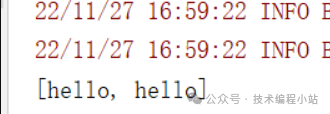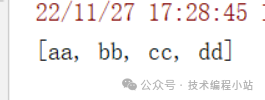Spark Transformations 算子
下面对相关常用算子进行演示。
三、Transformations 算子
1. map
将 RDD 中的数据 一对一 的转为另一种形式:
例如:
- scala:
val num = sc.parallelize(Seq(1, 2, 3, 4, 5))
println(
num.map(_+1).collect().toList
)
- java:
JavaRDD<Integer> num = sc.parallelize(Arrays.asList(1, 2, 3, 4, 5));
System.out.println(
num.map(i -> i + 1).collect()
);
- python:
num = sc.parallelize((1, 2, 3, 4, 5))
print(
num.map(lambda i:i+1).collect()
)

2. flatMap
和 Map 算子类似,但是 FlatMap 是一对多,并都转化为一维数据:
例如:
- scala:
val text = sc.parallelize(Seq("abc def", "hello word", "dfg,okh", "he,word"))
println(
text.flatMap(_.split(" ")).flatMap(_.split(",")).collect().toList
)
- java:
JavaRDD<String> text = sc.parallelize(Arrays.asList("abc def", "hello word", "dfg,okh", "he,word"));
System.out.println(
text.flatMap(s ->Arrays.asList(s.split(" ")).iterator())
.flatMap(s ->Arrays.asList(s.split(",")).iterator())
.collect()
);
- python:
text = sc.parallelize(("abc def", "hello word", "dfg,okh", "he,word"))
print(
text.flatMap(lambda s: s.split(" ")).flatMap(lambda s: s.split(",")).collect()
)

3. filter
过滤掉不需要的内容:
例如:
- scala:
val text = sc.parallelize(Seq("hello", "hello", "word", "word"))
println(
text.filter(_.equals("hello")).collect().toList
)
- java:
JavaRDD<String> text = sc.parallelize(Arrays.asList("hello", "hello", "word", "word"));
System.out.println(
text.filter(s -> Objects.equals(s,"hello"))
.collect()
);
- python:
text = sc.parallelize(("hello", "hello", "word", "word"))
print(
text.filter(lambda s: s == 'hello').collect()
)

4. mapPartitions
和 map 类似,针对整个分区的数据转换,拿到的是每个分区的集合:
例如:
- scala:
val text = sc.parallelize(Seq("hello", "hello", "word", "word"), 2)
println(
text.mapPartitions(iter => {<!-- -->
iter.map(_ + "333")
}).collect().toList
)
- java:
JavaRDD<String> text = sc.parallelize(Arrays.asList("hello", "hello", "word", "word"), 2);
System.out.println(
text.mapPartitions(iter -> {<!-- -->
List<String> list = new ArrayList<>();
iter.forEachRemaining(s -> list.add(s+"333"));
return list.iterator();
}).collect()
);
- python:
text = sc.parallelize(("hello", "hello", "word", "word"), 2)
def partition(par):
tmpArr = []
for s in par:
tmpArr.append(s + "333")
return tmpArr
print(
text.mapPartitions(partition).collect()
)

5. mapPartitionsWithIndex
和 mapPartitions 类似, 只是在函数中增加了分区的 Index :
例如:
- scala:
val text = sc.parallelize(Seq("hello", "hello", "word", "word"), 2)
println(
text.mapPartitionsWithIndex((index, iter) => {<!-- -->
println("当前分区" + index)
iter.map(_ + "333")
}, true).collect().toList
)
- java:
JavaRDD<String> text = sc.parallelize(Arrays.asList("hello", "hello", "word", "word"), 2);
System.out.println(
text.mapPartitionsWithIndex((index, iter) -> {<!-- -->
System.out.println("当前分区" + index);
List<String> list = new ArrayList<>();
iter.forEachRemaining(s -> list.add(s + "333"));
return list.iterator();
}, true).collect()
);
- python:
text = sc.parallelize(("hello", "hello", "word", "word"), 2)
def partition(index, par):
print("当前分区" + str(index))
tmpArr = []
for s in par:
tmpArr.append(s + "333")
return tmpArr
print(
text.mapPartitionsWithIndex(partition).collect()
)

6. mapValues
只能作用于 Key-Value 型数据, 和 Map 类似, 也是使用函数按照转换数据, 不同点是 MapValues 只转换 Key-Value 中的 Value:
例如:
- scala:
val text = sc.parallelize(Seq("abc", "bbb", "ccc", "dd"))
println(
text.map((_, "v" + _))
.mapValues(_ + "66")
.collect().toList
)
- java:
JavaRDD<String> text = sc.parallelize(Arrays.asList("abc", "bbb", "ccc", "dd"));
System.out.println(
text.mapToPair(s -> new Tuple2<>(s, "v" + s))
.mapValues(v -> v + "66").collect()
);
- python:
text = sc.parallelize(("abc", "bbb", "ccc", "dd"))
print(
text.map(lambda s: (s, "v" + s)).mapValues(lambda v: v + "66").collect()
)

7. sample
可以从一个数据集中抽样出来一部分, 常用作于减小数据集以保证运行速度, 并且尽可能少规律的损失:
第一个参数为withReplacement, 意为是否取样以后是否还放回原数据集供下次使用, 简单的说,如果这个参数的值为 true, 则抽样出来的数据集中可能会有重复。
第二个参数为fraction, 意为抽样的比例。
第三个参数为seed, 随机数种子, 用于 Sample 内部随机生成下标,一般不指定,使用默认值。
例如:
- scala:
val num = sc.parallelize(Seq(1, 2, 3, 4, 5, 6, 7, 8, 9, 10))
println(
num.sample(true,0.6,2)
.collect().toList
)
- java:
JavaRDD<Integer> num = sc.parallelize(Arrays.asList(1, 2, 3, 4, 5, 6, 7, 8, 9, 10));
System.out.println(
num.sample(true, 0.6, 2).collect()
);
- python:
num = sc.parallelize((1, 2, 3, 4, 5, 6, 7, 8, 9, 10))
print(
num.sample(True, 0.6, 2).collect()
)

8. union
两个数据并集,类似于数据库的 union :
例如:
- scala:
val text1 = sc.parallelize(Seq("aa", "bb"))
val text2 = sc.parallelize(Seq("cc", "dd"))
println(
text1.union(text2).collect().toList
)
- java:
JavaRDD<String> text1 = sc.parallelize(Arrays.asList("aa", "bb"));
JavaRDD<String> text2 = sc.parallelize(Arrays.asList("cc", "dd"));
System.out.println(
text1.union(text2).collect()
);
- python:
text1 = sc.parallelize(("aa", "bb"))
text2 = sc.parallelize(("cc", "dd"))
print(
text1.union(text2).collect()
)

9. join,leftOuterJoin,rightOuterJoin
两个(key,value)数据集,根据 key 取连接、左连接、右连接,类似数据库中的连接:
例如:
- scala:
val s1 = sc.parallelize(Seq("1,3", "2,6", "3,8", "4,2"))
val s2 = sc.parallelize(Seq("1,小明", "2,小张", "3,小李", "4,小红", "5,张三"))
val s3 = s1.map(s => (s.split(",")(0), s.split(",")(0)))
val s4 = s2.map(s => (s.split(",")(0), s.split(",")(1)))
println(s3.join(s4).collectAsMap)
println(s3.leftOuterJoin(s4).collectAsMap)
println(s3.rightOuterJoin(s4).collectAsMap)
- java:
JavaRDD<String> s1 = sc.parallelize(Arrays.asList("1,3", "2,6", "3,8", "4,2"));
JavaRDD<String> s2 = sc.parallelize(Arrays.asList("1,小明", "2,小张", "3,小李", "4,小红", "5,张三"));
JavaPairRDD<String, String> s3 = s1.mapToPair(s -> new Tuple2<>(s.split(",")[0], s.split(",")[1]));
JavaPairRDD<String, String> s4 = s2.mapToPair(s -> new Tuple2<>(s.split(",")[0], s.split(",")[1]));
System.out.println(s3.join(s4).collectAsMap());
System.out.println(s3.leftOuterJoin(s4).collectAsMap());
System.out.println(s3.rightOuterJoin(s4).collectAsMap());
- python:
s1 = sc.parallelize(("1,3", "2,6", "3,8", "4,2"))
s2 = sc.parallelize(("1,小明", "2,小张", "3,小李", "4,小红", "5,张三"))
s3 = s1.map(lambda s:(s.split(",")[0], s.split(",")[0]))
s4 = s2.map(lambda s:(s.split(",")[0], s.split(",")[1]))
print(s3.join(s4).collectAsMap())
print(s3.leftOuterJoin(s4).collectAsMap())
print(s3.rightOuterJoin(s4).collectAsMap())

10. intersection
获取两个集合的交集 :
例如:
- scala:
val s1 = sc.parallelize(Seq("abc", "dfe", "hello"))
val s2 = sc.parallelize(Seq("fgh", "nbv", "hello", "word", "jkl", "abc"))
println(
s1.intersection(s2).collect().toList
)
- java:
JavaRDD<String> s1 = sc.parallelize(Arrays.asList("abc", "dfe", "hello"));
JavaRDD<String> s2 = sc.parallelize(Arrays.asList("fgh", "nbv", "hello", "word", "jkl", "abc"));
System.out.println(
s1.intersection(s2).collect()
);
- python:
s1 = sc.parallelize(("abc", "dfe", "hello"))
s2 = sc.parallelize(("fgh", "nbv", "hello", "word", "jkl", "abc"))
print(
s1.intersection(s2).collect()
)

11. subtract
获取差集,a - b ,取 a 集合中 b 集合没有的元素:
例如:
- scala:
val s1 = sc.parallelize(Seq("abc", "dfe", "hello"))
val s2 = sc.parallelize(Seq("fgh", "nbv", "hello", "word", "jkl", "abc"))
println(
s1.subtract(s2).collect().toList
)
- java:
JavaRDD<String> s1 = sc.parallelize(Arrays.asList("abc", "dfe", "hello"));
JavaRDD<String> s2 = sc.parallelize(Arrays.asList("fgh", "nbv", "hello", "word", "jkl", "abc"));
System.out.println(
s1.subtract(s2).collect()
);
- python:
s1 = sc.parallelize(("abc", "dfe", "hello"))
s2 = sc.parallelize(("fgh", "nbv", "hello", "word", "jkl", "abc"))
print(
s1.subtract(s2).collect()
)

12. distinct
元素去重,是一个需要 Shuffled 的操作:
例如:
- scala:
val s1 = sc.parallelize(Seq("abc", "abc", "hello", "hello", "word", "word"))
println(
s1.distinct().collect().toList
)
- java:
JavaRDD<String> s1 = sc.parallelize(Arrays.asList("abc", "abc", "hello", "hello", "word", "word"));
System.out.println(
s1.distinct().collect()
);
- python:
s1 = sc.parallelize(("abc", "abc", "hello", "hello", "word", "word"))
print(
s1.distinct().collect()
)

13. reduceByKey
只能作用于 Key-Value 型数据,根据 Key 分组生成一个 Tuple,然后针对每个组执行 reduce 算子,传入两个参数,一个是当前值,一个是局部汇总,这个函数需要有一个输出, 输出就是这个 Key 的汇总结果,是一个需要 Shuffled 的操作:
例如:
- scala:
val s1 = sc.parallelize(Seq("abc", "abc", "hello", "hello", "word", "word"))
println(
s1.map((_, 1))
.reduceByKey(Integer.sum)
.collectAsMap
)
- java:
JavaRDD<String> s1 = sc.parallelize(Arrays.asList("abc", "abc", "hello", "hello", "word", "word"));
System.out.println(
s1.mapToPair(s -> new Tuple2<>(s, 1))
.reduceByKey(Integer::sum)
.collectAsMap()
);
- python:
s1 = sc.parallelize(("abc", "abc", "hello", "hello", "word", "word"))
print(
s1.map(lambda s: (s, 1))
.reduceByKey(lambda v1, v2: v1 + v2)
.collectAsMap()
)

14. groupByKey
只能作用于 Key-Value 型数据,根据 Key 分组, 和 ReduceByKey 有点类似, 但是 GroupByKey 并不求聚合, 只是列举 Key 对应的所有 Value,是一个需要 Shuffled 的操作。
GroupByKey 和 ReduceByKey 不同,因为需要列举 Key 对应的所有数据, 所以无法在 Map 端做 Combine, 所以 GroupByKey 的性能并没有 ReduceByKey 好:
例如:
- scala:
val s1 = sc.parallelize(Seq("abc", "abc", "hello", "hello", "word", "word"))
println(
s1.map((_, 1))
.groupByKey()
.collectAsMap
)
- java:
JavaRDD<String> s1 = sc.parallelize(Arrays.asList("abc", "abc", "hello", "hello", "word", "word"));
System.out.println(
s1.mapToPair(s -> new Tuple2<>(s, 1))
.groupByKey()
.collectAsMap()
);
- python:
s1 = sc.parallelize(("abc", "abc", "hello", "hello", "word", "word"))
print(
s1.map(lambda s: (s, 1))
.reduceByKey()
.collectAsMap()
)
